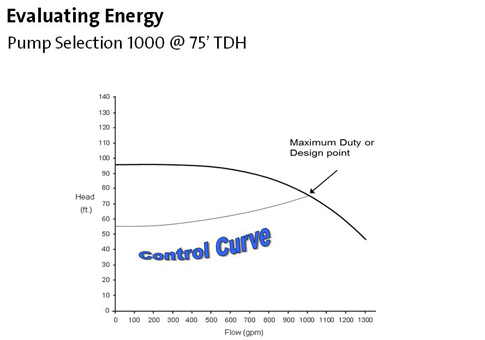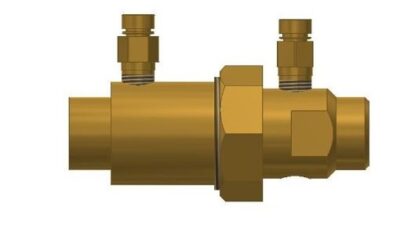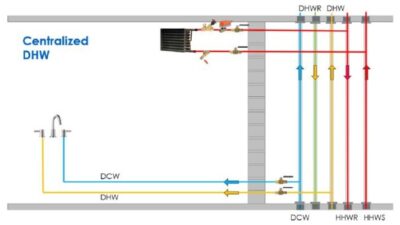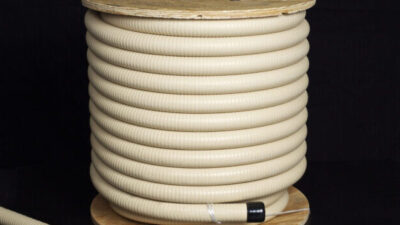Consulting engineers learned to evaluate and specify variable speed package pumping systems for various nonresidential building applications. Additional information is provided in this Q&A with the presenter.

The webcast on June 30 about evaluating variable speed packaged pumping systems left the audience wanting more information. Questions that went unanswered during the live event are answered here.
Question: Is there a maximum number of pumps running in parallel for optimum performance?
Keith Williams: Grundfos makes systems up to six pumps standard, however, they have done custom systems with more pumps. The ideal number of pumps should be based on the required minimum load and the desire for N, N+1, N+2, etc. Their standard systems go beyond 3000 gpm, which covers more than 90% of most pump systems being designed.
Question: Are variable speed drive (VSD) motors more efficient than none?
Williams: VSDs have an energy penalty over a motor without a variable frequency drive (VFD) when running at 60 Hz. The true savings with the VFD come from being able to run at lower Hz and thus save energy. This is over 95% of the time in most systems.
Question: Is control curve the same as system curve?
Williams: System and control curve are the same.
Question: It would be even better to redesign system to eliminate the 1 hr/day peak demand of 900 gpm, then switch to a smaller pump.
Williams: Each system needs to be evaluated based on peak demand and partial demand. This is why many packaged systems have three 50% pumps.
Question: What weight should the designer place on net positive suction head required (NPSHr)? The pump 4 NPSHr is higher, which will be a recipe for cavitation if one is not careful.
Williams: NPSHr is very critical for open loop systems like cooling tower loops and or tank fill operations. It should be very carefully considered. The designer should further ensure that piping is installed to meet design requirements.
Question: We can use HVAC in low heat?
Williams: Multistage pumps are acceptable in low-heat applications.
Question: Why did you not need a triple-duty valves for the second system?
Williams: The triple-duty valve (check, isolation, and balance) are not used in the variable flow system. We do still need the check and isolation and those are included in the packaged system. The balance is not needed as the VFD is adjusting for the desired pressure. Remember that the balance portion of the triple duty valve is to create head pressure to drive the pump to the desired flow by adding head. This uses energy and is not a desired energy solution compared to using a VFD to achieve the desired flow.
Question: The impellor of the vertical multistage (VMS) pump has less mass, but is called on to pump the same head and volume. How does the durability of the impellor hold up compared to the end suction pump?
Williams: VMS pumps are designed for rugged duty applications. Remember that the mass of the bronze fitted impeller is required as a result of the large diameter. With the multistage pump (which creates it head pressure through multiple impellers that are smaller) the diameter is much smaller and thus the forces are significantly less, which results in the lower weight. Additionally, the consistency of the manufacturer of most multistage pumps is superior to the casting process used in bronze fitted pumps.
Question: Is this package system a duplex or triplex compared to the two end-suction pumps?
Williams: In the example we compared two 100% end suction pumps to three 50% multistage pumps. For each system the best way to get to the flow and head were used to ensure the best of each system was evaluated.
Question: How do you balance the packaged pumps without triple duty valves? Controls need to be integrated with building automation systems (BAS). Where is that cost?
Williams: The packaged pumping variable flow system balances itself. Based on the differential pressure sensor in the system, the control panel takes the desired set point and then modulates the pumps (via the VFDs) to meet the flow and head requirements in the most efficient manner.
Question: Is there any case where you would not put a VFD on each pump in parallel multi-pump installations?
Williams: The cost for using one VFD for multiple pumps has rarely been an advantage for low-flow applications (systems under 2000 gpm). It could be evaluated on a case-by-case basis, but remember that if you lose your VFD, then you have lost both pumps.
Question: Which selection of pumps work better with part load?
Williams: VMS pumps are very good at partial loads as can be seen in the energy analysis slides (both at 3500 and 1750 rpm).
Question: Do these same cost savings scale downward to smaller pumps, say 50 gpm and 200 ft head?
Williams: Cost savings should be higher with the higher head application as the single stage end suction pumps get very expensive with high head applications. This is due to the large impellers and large casing costs on a single stage end suction pump. (There could also be additional savings in smaller head and flow systems, as some of the packaged pump systems come with permanent magnet motors, and integrated VFDs.)
Question: Did you evaluate the advantage of having a pressure sensor in the package instead of having it in a remote position?
Williams: For Grundfos, the pressure sensors come installed standard in the headers and the system controller with proportional differential pressure in the standard controller. It can also take an external set point for differential pressure standard. So the cost is essentially the same. Cost for the end suction differential pressure was considered as a part of the field installation costs.
Question: With the integrated controls offered with packaged pump systems what control integration options are offered?
Williams: I would suggest a long discussion with your local representative. There are multiple control strategies with Grundfos that come standard. As for other manufacturers, I have not investigated their options to any great detail. Grundfos, for instance, offers a low inlet pressure shut-off to protect the pumps in case of low pump entering pressure. It’s a nice feature to protect the pumps for cavitation failure.
Question: Please compare horizontal multistage pumps to vertical multistage pumps, such as both examples manufactured by Grundfos.
Williams: Energy efficiencies are very similar and thus the evaluation is basically the same. The internal components are the exact same with just the casing being different (CR versus CRH) the real difference would be footprint.
Question: Is there one equation that relates the energy or energy saving to the VFD frequency? What is it?
Williams: No one equation but small speed changes will bring larger brake horsepower reductions.
Question: Are vertical, multistage pumps recommended for open, condenser water applications despite the caustic nature of the water?
Williams: We have used them in condenser water applications with 304 stainless steel. However, based on your chemical make-up, we can offer 316 stainless steel and titanium as well.
Question: As an independent commissioning authority, I like to assure that the documentation is available and training is provided to the current staff and documentation is available for future staff. Additionally, I like to exercise the system through its full operating sequence, including failure. How detailed are the control sequences specified in package systems?
Williams: The pumps are pre-tested at the factory individually from Grundfos and as a packaged system from Grundofs. This is standard operating practice for these systems. Make sure they would allow you to witness this and of course the documentation is available. You would need to contact Granados for detailed control sequences.
Question: Does it make sense to have a pump package within a treatment plant that has its own programmable logic controller (PLC)?
Williams: Again, I believe that the manufacturer has the best ability to control their own pumps for best operating parameters and energy efficiency. By using a plant-based PLC, you are losing out on these advantages. Cost for plant-based PLC programming will likely exceed the cost of the Grundfos pump controller.
Question: Are VMS pumps designed also for pumping station domestic and sewage system?
Williams: Yes, these systems are an excellent solution for domestic pumping stations. As for sewage, these VMS pumps are not designed to be grinder pumps.
Question: Is there a break-even point in size/capacity where it might be more advantageous to purchase a field-built pump system versus packaged pump system?
Williams: In systems that are in excess of 2500 gpm, it should be evaluated as to the type of pump selected. I am a firm believer that packaging pumps on a skid will almost always be less than field built; however I am sure there are applications where it might not make sense.
Question: How often are impellers trimmed in the field? How can a pump be balanced when the owner is adding process equipment (for which the pump was sized). Equipment installation is over several months.
Williams: VMS pumps are not provided with trimmed impellers. They are offered with multiple impellers and sometimes at different sizes. The VFD is the prime way to "trim" the pump for flow and head.
Question: Is there a way to have the pumps submersible with the control panel in an attached dry chamber?
Williams: I would suggest asking your local representative about solutions that are beyond those offered in this seminar. There are lots of additional pump configurations and solutions that I was not able to present based on time.
Question: I faced a situation where a multistage pump fail due to bearing failure even the vibration reading shown at acceptable range, are there any method/approach to overcome the failure besides performing predictive maintenance?
Williams: I would suggest working directly with that manufacturer to determine why the pump failed in your application. It would seem to me to be a rare occurrence. Please note that the bearing/seal failures we typically see with the cartridge seal is the result of not priming the pump prior to "bumping" and/or running.
Question: Can the vertical package pump system be controlled by system temperature differential, rather than delta p?
Williams: Yes it can be controlled based on temperature. If you are looking for lower flow and head (like domestic hot water return), Grundfos makes a great pump for this application called the Magna 3.



